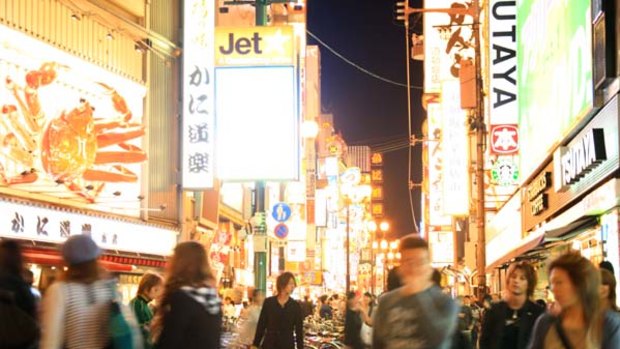
More than just sushi ... the famed neon lights of the Dotonbori district.Credit: Joanna Hall
Osaka is often referred to in travel guides as nondescript, industrial and architecturally bland, as Japanese cities go. As any local will tell you, however, it is a well-earned reputation as a gastronome's paradise that makes Osaka stand out from the crowd.
While Tokyo was recently declared by Michelin to be the centre of gourmet dining, beating Paris for the first time with a greater number of three-star restaurants, Osaka and neighbouring Kyoto have now been deemed worthy of a Michelin guide of their own.
Where Osaka is concerned, the roots of such an accolade lie with a food passion so strong among its people that the Japanese use a special phrase to describe the city. It's "kuidaore", which loosely translates as "to ruin oneself by extravagance in food".
At the fine-dining end, Osaka has a growing list of restaurants receiving acclaim, if not Michelin stars. Hanagatami, at the elegant Ritz-Carlton Osaka, is one. It specialises in traditional kaiseki cuisine, which is a fancy term for a gut-busting multi-course meal comprising the best elements of Japanese food: sushi, sashimi, tofu, soup, fish, vegetables, hotpot and a dessert.
All hotel concierges worth their salt, however, will direct most first-time visitors in search of a feed to Osaka's Dotonbori district - especially after dark. This part of Osaka is said to have inspired Ridley Scott's 1982 neo-noir classic Blade Runner; walking down the main drag it's easy to see why. From the noise, tourists and teenage fashionistas to the outlandish shop facades and dazzling neon billboards, the spectacle is overwhelming.
Dotonbori is also known for its canal, a giant mechanised pink Kani Doraku crab, a pick-up spot called Ebisubashi Bridge, a vibrant nightlife and, most of all, a staggering line-up of stalls, restaurants and cheap eateries.
If you pass a street stall here selling something resembling cooked table tennis balls, these are an Osakan delicacy. Called takoyaki, they are balls of fried dough stuffed with octopus and served with soy sauce and dried fish flakes. They taste much better than they sound.
Another essential Osakan dining experience, one that has spread throughout Japan, is okonomiyaki. Also called Japanese pizza, okonomiyaki is a thick, savoury pancake made from eggs and whatever else takes your fancy: chicken, pork, beef, octopus, green onions, noodles, cabbage or all the above.
In cheaper eateries, you get to cook the pancake yourself, usually on a hotplate in the centre of your table. In more expensive restaurants, such as Okonomiyaki Chibo, near the Namba subway station, a chef cooks it to order and brings it to your table on a hot griddle so you can graze at your leisure. Tokyo may arguably boast the best sushi on the planet but serving it conveyor belt-style was first developed in Osaka. Called kaiten, it was invented by Yoshiaki Shiraishi, who got the idea after watching beer bottles on a conveyor belt in an Asahi brewery.
Top of the list of local sushi specialties is oshi sushi. It's made from rice soaked in vinegar, which is pressed into a mould and then topped with marinated fish. The best place to try it is where the conveyor-belt craze began - Mawaru Genroku Sushi, in Higashi-Osaka City.
Osakans love their noodles and those at the heart of Osakan cuisine are called udon. Soft, thick white noodles made from wheat, they are most often served in a broth and make for a quick and hearty meal. There are many places to try them but for the widest choice, there's a collection of well-known noodle joints on the seventh floor of the food theme park at Namba Parks, in Chuo-ku.
To try something unique to Osaka, head for the Hanshin department store, in Umeda. It has an exclusive local savoury specialty called ikayaki, or grilled squid, which makes for a great snack while you are browsing.
Meat lovers should also check out a style of barbecued meat called yakiniku. Regarded as food that gives you stamina, it first spread across Japan from Osaka by way of the Korean peninsula and, as a result, the city has some of the most authentic restaurants in the country.
In east Osaka, Tsuruhashi is famous as Japan's largest collection of yakiniku barbecue eateries. Here you can take your pick of where to eat, however, one place that has a long-standing reputation is Tsuruichi Original Store.
TRIP NOTES
GETTING THERE
Jetstar flies daily from the Gold Coast to Osaka with connections from Sydney. Phone 131 538, see jetstar.com.
GETTING AROUND
Osaka has a good network of public transport. The Rainbow Card is a cheap and convenient way to go, as it covers the subway, the New Tram, city buses and some trains. Prices from ¥500 ($6) for an adult.
WHERE TO STAY
The Ritz-Carlton Osaka is in the heart of the Nishi-Umeda business and shopping district near Osaka Station, with 292 rooms and suites. A "reconnect" package is priced from ¥35,000 a night ($422) until April 30. For more information see ritzcarlton.com.
FURTHER INFORMATION
See www.osaka-info.jp/en.
Sign up for the Traveller Deals newsletter
Get exclusive travel deals delivered straight to your inbox. Sign up now.